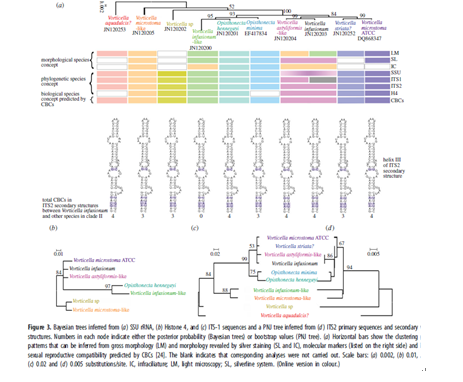Sun Ping,Clamp JC,Xu D,Huang B,Shin MK, Turner F.Proc. R. Soc. B,2013. 1177: 1471-2954.
Vorticella includes more than 100
currently recognized species and represents one of the most taxonomically
challenging genera of ciliates. Molecular phylogenetic analysis of Vorticella
has been performed so far with only sequences coding for small subunit
ribosomal RNA (SSU rRNA); only a few of its species have been investigated
using other genetic markers owing to a lack of similar sequences for
comparison. Consequently, phylogenetic relationships within the genus remain
unclear, and molecular discrimination between morphospecies is often difficult
because most regions of the SSU rRNA gene are too highly conserved to be
helpful. In this paper, we move molecular systematics for this group of
ciliates to the infrageneric level by sequencing additional molecular
markers-fast-evolving internal transcribed spacer (ITS) regions-in a broad
sample of 66 individual samples of 28 morphospecies of Vorticella collected
from Asia, North America and Europe. Our phylogenies all featured two strongly
supported, highly divergent, paraphyletic clades (I, II) comprising the
morphologically defined genus Vorticella. Three major lineages made up clade I,
with a relatively well-resolved branching order in each one. The marked
divergence of clade II from clade I confirms that the former should be
recognized as a separate taxonomic unit as indicated by SSU rRNA phylogenies.
We made the first attempt to elucidate relationships between species in clade
II using both morphological and multi-gene approaches, and our data supported a
close relationship between some morphospecies of Vorticella and Opisthonecta,
indicating that relationships between species in the clade are far more complex
than would be expected from their morphology. Different patterns of helix III
of ITS2 secondary structure were clearly specific to clades and subclades of
Vorticella and, therefore, may prove useful for resolving phylogenetic
relationships in other groups of ciliates.

返回

